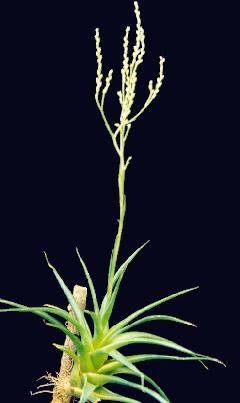
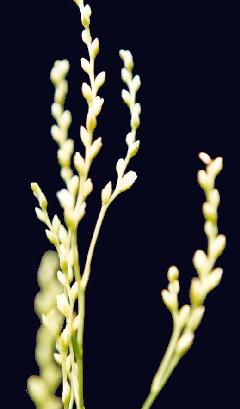
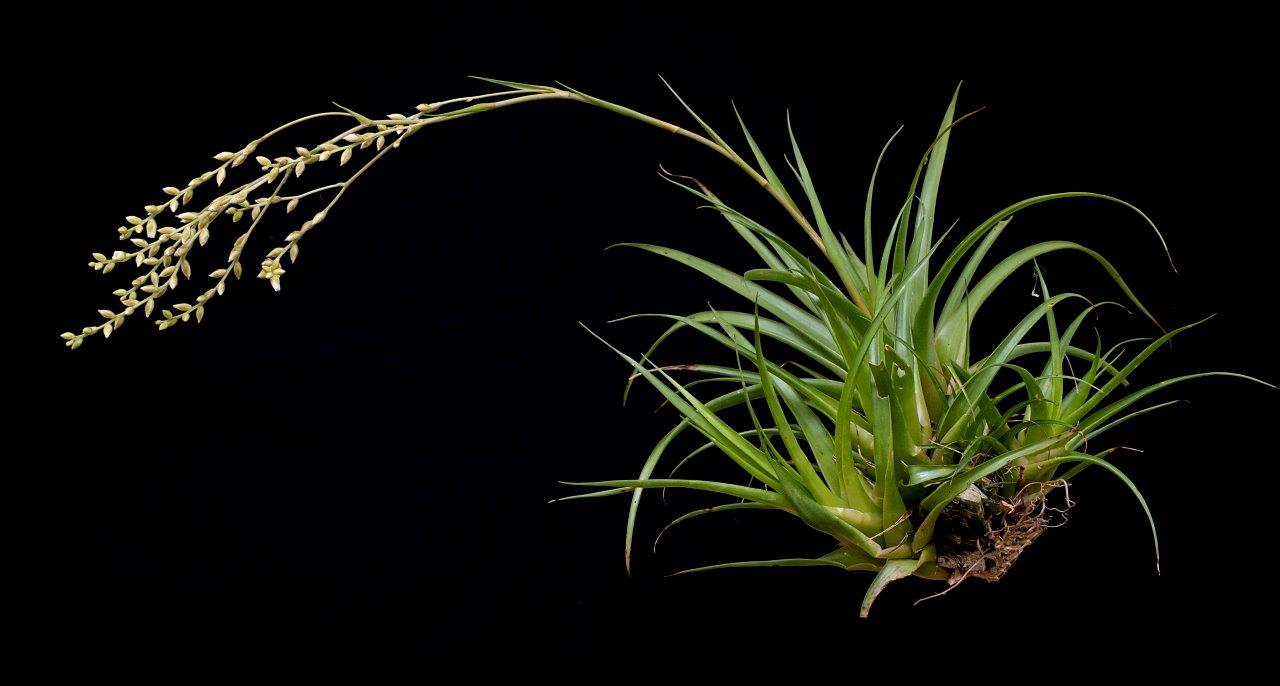
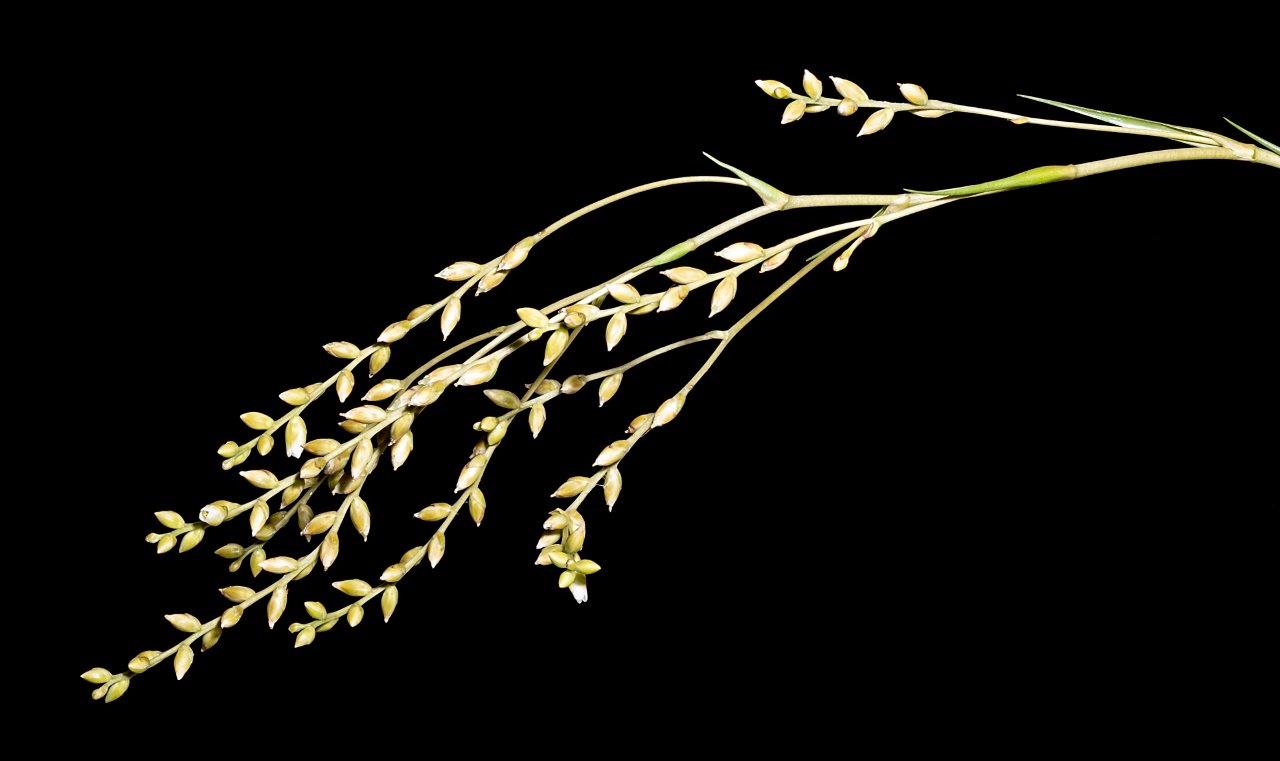
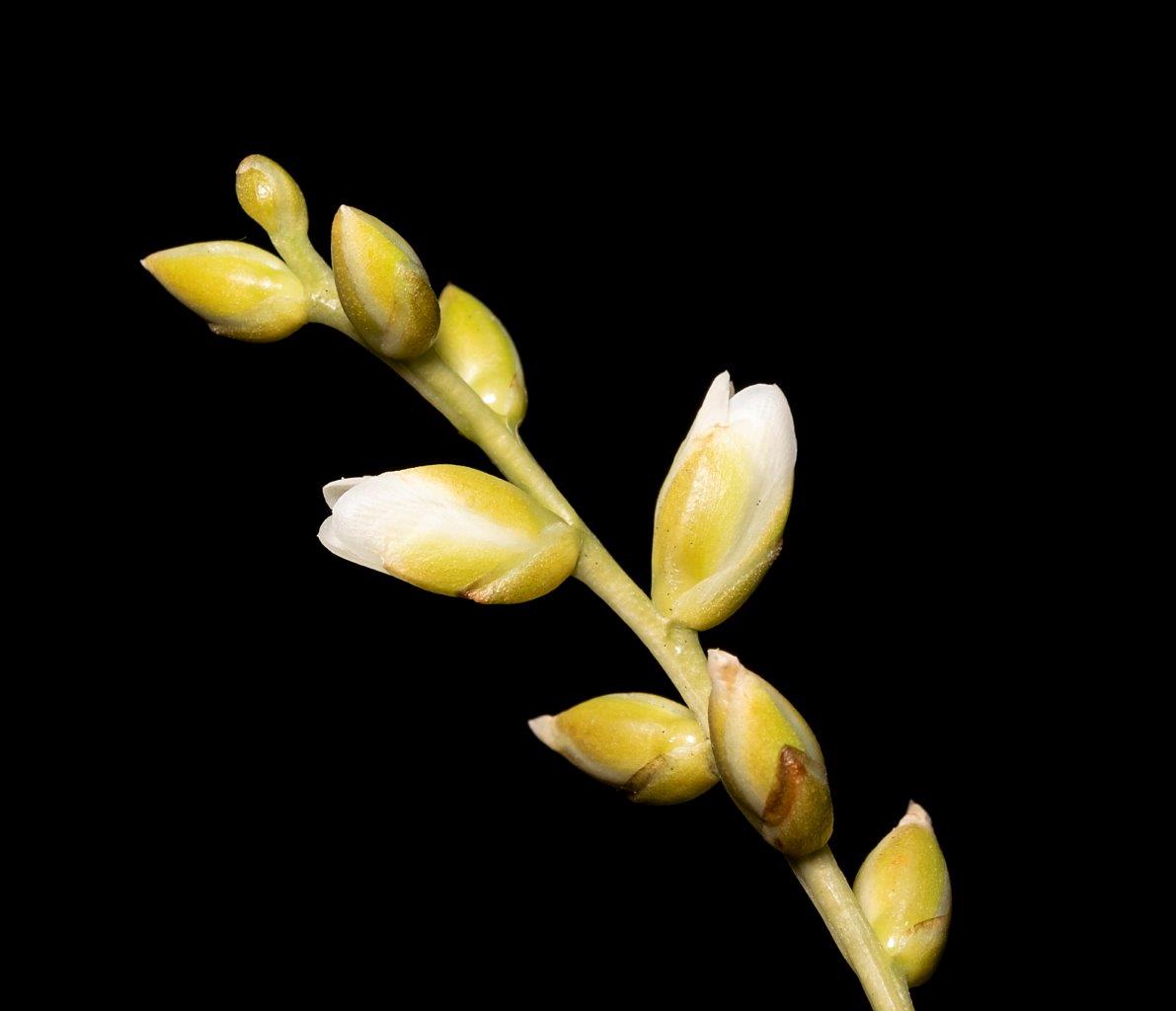
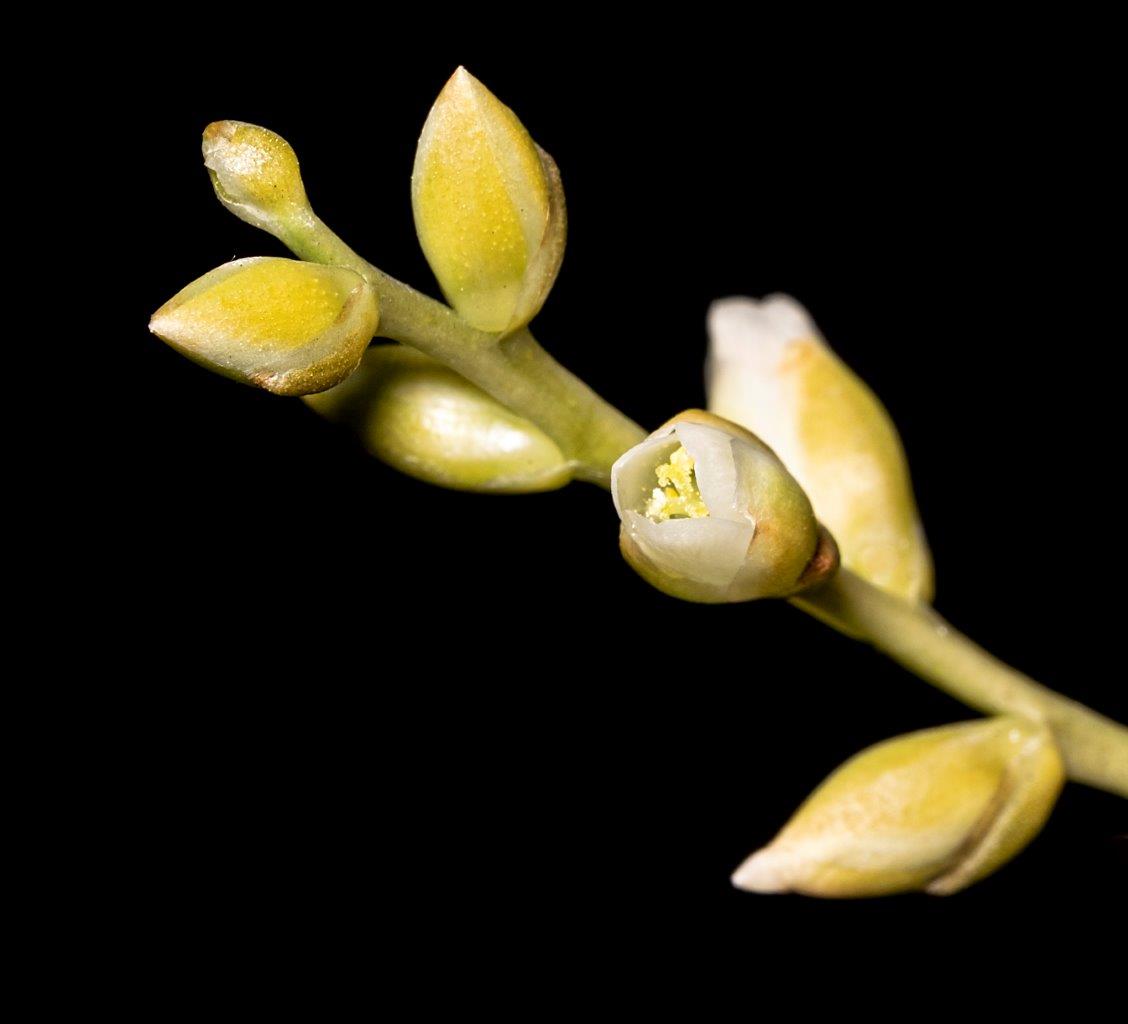
Catopsis floribunda L. B. Smith var. floribunda. Contr, Gray Herb. 117: 4, pl.l. figs. 4 and 5,1937.
Fogospermum floribundum Brongniart, Ann. Sci, Nat. 5 ( 1 ): 329, 1864.
Catopsis nutans (Sw.) Griseb., Fl. Brit. West Indies 599,1864; as to description and most of the material cited, not as to name-bringing synonym.
Catopsis montana L. B. Smith, as to type, not as to Central American material; type: Ekman 16555, Cuba, Pinar dei Rio, Mogotes in Sierra de Vinales, June 6,1923; type: GH!, staminate plant.
Holotype: Plee s.n., Martinique; F n. v.
Leaf-blades narrowly triangular, 0.8-2 (2.7) cm wide, the margins sometimes becoming revolute with age;
leaf sheaths gradually constricted into the blades;
lower primary bracts mostly shorter than the sterile bases of the spikes.
In montane forests, 0-1500 m; s. Florida (U.S.), Greater Antilles through Trinidad and Venezuela; rare in Guatemala and Costa Rica.
In flower trom May to September.
The name of this species is a combination of Pogospermum floribundum Brongniart who first recognized this taxon (L.B. Smith 1937). Mez (1894) provisionally annotated some of these plants as C. antillana (e.g., Eggers 2061, K!), a name that agrees with the distribution of this variety; however, Mez never published that name and therefore, it remains as an invalid name (W. Till, pers. comm.). The type specimen of C. montana L. B. Smith corresponds to a staminate plant of C. floribunda; both staminate and pistillate plants are now known from Pinar del Rio, Cuba. The few dioecious populations known to date have been recorded as growing on rocks.
Material examined: see appendix.
Catopsis floribunda var. occidentalis var. nova
Catopsis paniculata (E. Morren) Baker sensu L. B. Smith (1967), pro parte, not as to type.
Holotype: Palaci 1203, Costa Rica, San Jose, Poas de Aserri, 1500-1600m, 12 Aug 1993; RM.
Leaf blades (0.5) 1.5-2.5 (3.5) cm wide, flat;
leaf sheaths indistinct, gradually merging into the blades;
lower primary bracts longer than the sterile bases of the spikes.
In premontane wet forests and cloud forests, 400-1800m; s. Mexico, Honduras, Guatemala, Nicaragua, Costa Rica.
In flower from May to September.
C. floribunda var. occidentalis differs from the typical variety in its wider leaves with indistinct sheaths, and the lower primary bracts often exceeding the sterile bases of the spikes. L B. Smith (1937) placed plant material of this variety alternatively within C. floribunda and then within C. paniculata (E. Morren) Baker sensu Smith & Downs 1977, based on the relative length of the primary bracts respect the sterile bases of the spikes. Material from Central America exhibits variable length of the primary bracts, which can only be used as a secondary character to distinguish the two varieties. The geographical separation between the two varieties may account for some of their differences in vegetative features.
Catopsis floribunda L. B. Smith, Contr. Gray Herb. 11'7: 5. 1937.
Pogospermum floribundum Brongniart, Ann. Sci. Nat. V. I: 329. 1864; nomen provisorium.
Catopsis nutans sensu Grisebach, Fl. Brit. W. Indies 599. 1864; in part, not as to type.
Desc from S&D
Plant flowering 4-7 dm high.
Leaves many in a dense rosette, suberect, stiff, 2-4 dm long, obscurely punctulate-lepidote throughout, not at all cretaceous-coated;
sheaths elliptic, from half as long to as long as the blades, faintly castaneous toward the base;
blades narrowly triangular, attenuate, 15-30 mm wide at the base, flat or involute with extreme age.
Scape erect, 2-4 mm in diameter, glabrous;
scape-bracts erect, exceeding the internodes, the lower foliaceous, the upper very narrowly triangular from an ovate base.
Inflorescence laxly bipinnate or tripinnate, 15-40 cm long, glabrous;
primary bracts like the upper scape-bracts, usually much shorter than the sterile bases of the axillary branches;
branches strict;
spikes slenderly long-stipitate, subdensely 8-36-flowered, to 16 cm long including the stipe.
Floral bracts subspreading, broadly ovate, obtuse, 3-5 mm long, distinctly shorter than the sepals, prominently nerved, green, the broad margin turning dark brown with age;
flowers suberect.
Sepals strongly asymmetric, broadly elliptic, 4-6 mm long, exactly like the floral bracts in texture and coloration;
petals elliptic, 7 mm long, obtuse, white;
stamens distinctly unequal, the second series connate with the petals for 1.5 mm;
ovary stoutly ellipsoid; stigmas subsessile.
Capsule slenderly ovoid, acute, 9-11 mm long.
TYPE. Plee s n (holotype P), Martinique.
DISTRIBUTION. Epiphytic in forest, from near sea level to 1490 m alt, southern Florida, the West Indies, Trinidad and Venezuela.
UNITED STATES. FLORIDA, Collier County: without exact locality, 20 Jul 1942, Foster 1205 (GH); Dade County: Cutler, 1903, Eaton s n (GH); Nov 1903, Small & Carter s n (F, US); Sykes Hammock, Redland, 23 Feb 1915, Small & Mosier 5499 (NY, US); 2 Feb 1930, Moldenke 557 (NY, US); Homestead, 25 Sep 1929, O'Neill s n (US); 31 Mar 1933, s n (F). CUBA. PINAR DEL RIO: Rangel, Wright 674 e p (US); Sumidero, Aug 1912, Shafer 13732 (NY, US); 13765 (NY, US); La Guira, 10 Jun 1938, Carabia 26 (LS). LAS VILLAS: Cieneguita, Cienfuegos, Combs 638 (GH); Buenos Aires, Sierra de Trinidad, Dec 1928, Jack 6804 (GH); 6856 (GH); 4 May 1932, Roig & Acuna 6263 (SV); 11 Nov 1941, Morton 4195 (US); San Blas, Sierra de Trinidad, 11 Apr 1930, Jack 7872 (GH); San Jose, Sierra de Trinidad, 29 Jul 1936, L. B. Smith, Hodgdon & Gonzalez 3293 (GH); Topes de Collantes, Sierra de Trinidad, 27 Jul 1938, Leon 18428 (LS); 29 Jul 1938, Leon 149 (LS); 8 Apr 1940, Acuna 11127 (F, SV, US); San Blas, Sierra de Trinidad, Jun 1941, Howard 5379 (GH); Aug 1941, 6443 (GH); Placetas, La Victoria, 3 Jul 1940, Acuna 11139 (US). CAMAGUEY: La Gloria, 8 Feb 1909, Shafer 1850 (F, US). ORIENTE: Monteverde, 1859, Wright 674 e p (GH); Sierra de Nipe, 18 Jan 1910, Shafer 3596 (NY, US); Jul 1941, Howard 6143 (GH); 18 Oct 1941, Morton 3301 (US); Bayate, 27 Jul 1915, Ekman 6277 (S); Guantanamo, 28 Nov 1922, Ekman 15809 (S); Manzanillo, 18 Mar 1938, Carabia 13 (LS); Maisi, 8 Jul 1938, Leon 153 (LS); Baracoa, Jul 1938, Leon 18292 (LS); 92 (LS). JAMAICA. ST. ANDREW: Blue Mountains, 2 Jun 1894, Harris 5161 (GH). ST. CATHARINE: Juan de Bolas, 5 Aug 1952, Proctor 7130 (IJ, US). ST. ANN: Mount Diabolo, Feb 1920, Maxon & Killip 535 (US); Cave Valley, 23 Jun 1955, Proctor 10375 (IJ, US); Killits, 2 Mar 1957, Proctor 16207 (IJ, US). MANCHESTER: Coleyville, 10 Jun 1952, Proctor & Hines 6782 (IJ, US). Without exact locality: Apr 1844, Purdie s n (K). HAITI. Port Margot to Correil, 8 Aug 1903, Nash 273 (F); Marmelade, Nord, 19 Dec 1925, Leonard 8263 (US); Riviere Glace, 6 Aug 1945, Holdridge 2180 (US); Port-au-Prince, 11 Sep 1955, Proctor 10672 (IJ, US). REPUBLICA DOMINICANA. Pico de Igua, 15 Aug 1946, Jimenez 1283 (US); Jarabacoa, 18 Oct 1947, Jimenez 1537 (US); Pico de Diego Ocampo, 31 Aug 1947, Jimenez 1479 (US); Hotel Montana, La Vega, 11 Dec 1955, Jimenez & Ariza Julia 3148 (US); without exact locality, Eggers 2061 (B). PUERTO RICO. Maricao, Nov 1884, Sintenis s n (GH); s d, 476 (K); Monte Torito, Cayey, 13 Oct 1885, Sintenis 2043-B (TRIN, US); s d, 4043-B (K); Caguas, 24 Mar 1906, Britton & Cowell 1404 (NY, US); Maricao to Monte Alegrillo, 3 Apr 1913, Britton, Stevens & Hess 2560 (US); Bayamon, 1 Jan 1914, Stevenson 1144 (US); Sierra de Naguabo, 19 Jul 1914, Shafer 3257 (NY, US); Monte Montoso, 13 Feb 1915, Britton & Cowell 4126 (NY, US); Jayuya, 14 Aug 1943, Sargent 3072 (US); Hato Tejas, 30 Nov 1963, Alain Liogier 10369 (NY, US); 22 Feb 1964, 10695 (NY, US); Villalba, Ponce, 6 Jul 1965, Stimson 1668 (DUKE, US). VIRGIN ISLANDS. Tortola, Eggers 3199 (K); 1 Feb 1919, Fishlock 373 (GH); St. John, Mar 1906, Raunkiaer s n (C); St. Thomas, Jul 1874, Eggers s n (C); 29 Aug 1876, s n (GH); 6 Nov 1881, s n (US); s d, 1058-B (Z). LEEWARD ISLANDS. ST. MARTIN: 29 Aug 1906, Boldingh 2854 (U); 10 Sep 1906, 3237 (U). SABA: Jul 1906, Boldingh 1358 (U); 1622 (U); 30 May 1953, Stoffers 3459 (U). ST. EUSTATIUS: 2 Jun 1906, Boldingh 1734 (U); 25 Jul 1953, Stoffers 3900 (U). ANTIGUA: Wullschlaegel 561 e p (GOET, M); 7 Nov 1937, Box 1255 (US); 9 Apr 1956, A. C. Smith 10485 (US); 22 Sep 1965, Martinez & Guerra s n (US). MONTSERRAT: 30 Jan 1907, Shafer 355 (F); 16 Feb 1907, 699 (US); 5 Oct 1966, Aitken, Martinez & Guerra s n (US). GUADELOUPE: 1839, Beaupertius s n (P); Bagatelle, 1894, Duss 3324 (US); Gourbeyre, 10 Nov 1925, Stehle 474 (US); Baines Jaunes, 10 Oct 1936, Stehle 2013 (US); Sainte Rose, 13 Sep 1937, Stehle 2800 (US); St. Claude; 18 Mar 1938, Questel2042 (US). DOMINICA: lmray 219 (K); Lisdara, Aug 1937, Hodge 321 (GH); Sylvania Estate, Aug 1938, Hodge 322 (GH); Laudat, 12 Mar 1940, Hodge 1999 (GH); 28 June 1965, Martinez & Guerra s n (US); Morne Anglais, 21 Mar 1940, Hodge 2249 (GH); La Chaudiere, May 1940, Hodge 3637 (GH); Salisbury, 16 Jun 1967, Wasshausen & Ayensu 401 (US). WINDWARD ISLANDS. MARTINIQUE: Hahn 523 e p (P); 579 (P); Jun 1870, Hahn 1529 (S); Fonds St. Denis, 15 Mar 1940, Stehle 6507 (US). ST. LUCIA: Anderson s n (K); Ramage s n (BM, K); 13 Jul 1945, Beard 524 (GH); Marigot Lagoon, 21 Mar 1956, A. C. Smith 10198 (US); Barre de l’Isle, 6 Aug 1964, Martinez s n (US). St. Vincent: H. H. & G. W. Smith 774 (K); Calvary, Dec 1889, Eggers 6675 (US). VENEZUELA. NUEVA ESTARTA: La Soledad, Dec 1951, Gines 2825 (US); Aug 1953, 4026 (US). SUCRE: Cristobal Colon, 1923, Broadway 806 (GH, US). MIRANDA: Parque Nacional de Guatopo, 28 Nov 1961, Steyermark 90151 (US, VEN). ARAGUA: Rancho Grande, 24 Oct 1951, Foster 2777 (US). FALCON: Curimagua, Sierra San Luis, 18 Jul 1967,Steyermark 99078 (US, VEN). LARA: Cerro Gordo, Barquisimeto, Jan 1924, Saer 106 (GH, US). TRINIDAD. La Brea, Crueger in Herb. Trin. 2003 (TRIN, US); Arima, 1901, Dannouse s n (TRIN); Crane 49 (TRIN); 27 May 1924, Riley 223 (BM); Arima Valley, Aitken 258 (TRIN); Caparo, Broadway 2675 (F); Tabaquite, 19 Oct 1918, Broadway s n (TRIN, US); 20 Oct 1954, Aitken 29 (TRIN, US); 3 Dec 1955, Simmonds s n (TRIN); Maracas, Broadway 5364 (F, MO); Cumuto, Broadway s n (TRIN); Cumaca, 9 Jul 1954, Downs s n (TRIN, US); Sangre Grande, 7 May 1955, Aitken s n (TRIN, US); Tamana, 1944, Pittendrigh 1003 (US); Long Stretch, Simmonds 372 (TRIN); Moruga Bouffe, Aitken & Downs s n (TRIN). TOBAGO. Main ridge north of Roxborough, 31 Jul 1957, Aitken s n (TRIN, US).
Catopsis montana L. B. Smith, Contr. Gray Herb. 117: 6, pl. 1, figs. 9, 10. 1937.
Treated as a synonym of C. floribunda by Palaci 1997
Plant flowering 6 dm high.
Leaves many in a cyathiform rosette, 40-45 cm long, covered with a cretaceous powder;
sheaths elliptic, about as long as the blades but indistinct, obscurely punctulate-lepidote;
blades linear-lanceolate, acuminate, to 33 mm wide, flat.
Scape erect, slender, glabrous;
scape-bracts erect, the lower ones subfoliaceous; densely imbricate, the upper ones long-acuminate from an ovate base, equaling the internodes.
Inflorescence laxly particulate, many-flowered, 25 cm long;
primary bracts like the scape-bracts, much shorter than the sterile bases of the branches;
lower branches slightly divided, divergent; upper branches simple, spreading;
spikes short-stipitate, 3-13 cm long, laxly many-flowered.
Floral bracts broadly ovate, subacute, 3-4 mm long, much shorter than the sepals, prominently nerved;
flowers subspreading, probably perfect.
Sepals broadly elliptic, strongly asymmetric, 6 mm long with the lateral wing extended;
petals elliptic, obtuse, 6 mm long but slightly exserted, flavous;
stamens slightly unequal; style short but distinct.
TYPE. Ekman 16555 (holotype GH, isotype S), mogotes in Sierra de Vinales, Pinar del Rio, Cuba, 6 Jun 1923.
DISTRIBUTION. Epiphytic in forest and rarely saxicolous, 1100-1600 m alt, southern Mexico to Honduras, Cuba.,
MEXICO. OAXACA: without exact locality, 1948, MacDougall s n (US). GUATEMALA. QUEZALTENANGO: San Jose Buena Vista, Costa Cuca, 17 Jan 1930, Rodriguez 1672 (P); Santa Maria de Jesus, 11 Mar 1939, Standley 68273 (F, GH). JALAPA: Cerro Alcoba, Jalapa, 2 Dec 1939, Steyermark 32540 (F). SOLOLA: Rio Bravo, Volcan Atitlan, 21 Jun 1942, Steyermark 47942 (F, GH). HONDURAS. MORAZAN: Montana Uyuca, 7 Aug 1946, Williams & Molina 10267 (F, GH); 22 Feb 1947, Standley & Molina 4268 (F); 15 Jul 1964, Gilmartin 986 (US); 988 (US); 990 (US); Molina 14556 (EAP, F, US); Aug 1960, Pfeifer 1391 (US); 1421 (US); 1820 (US); La Tumplada, km 26 Tegucigalpa to Zamorana, 9 Jul 1964, Gilmartin 955 (US); Lago de Ponce, Montana La Tigra, 13 Jul 1964, Gilmartin 972 (US); San Juancito, Aug 1960, Pfeifer 2027 (US). CUBA. PINAR DEL RIO: Sierra Caliente, Sumidero, 15 Aug 1912, Shafer 13765 (F).